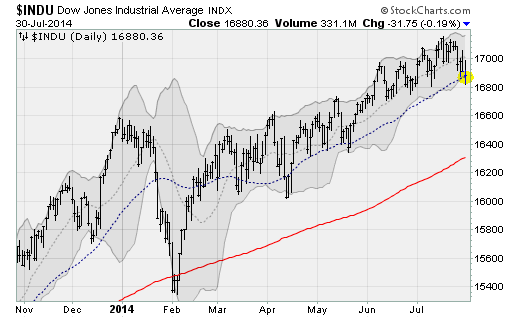The Fed has investor psychology at a crossroad
Stocks suffered a bout of volatility on Wednesday in response the release of the latest Federal Reserve meeting statement as well as some solid economic data. The Dow Jones industrial average fell to test its 50-day moving average for the first time since May, potentially ending a period of low volatility and easy gains.
This boils down to the fact that good news is apparently bad news, because the strengthening economy means the market is about to lose the support of the Fed's cheap-money pumping for the first time in two years. It also could bring forward the timing of the first short-term interest rate hike. It's worth noting that it's been eight years since the Fed last increased the cost of money. So it's kind of a big deal.
Investors are understandably growing nervous -- a behavior we've already seen reflected in recent pullbacks in more sensitive areas of the market including small-cap stocks, high-yield corporate bonds and sectors including biotechnology, industrials, transports and semiconductors.
The selling intensified as investors digested the Fed's statement, which analysts at Goldman Sachs noted had a "slightly hawkish tilt" as it acknowledged recent improvements to economic growth, the job market and an increase in inflation to near the Fed's 2 percent annual target.
The one dovish throwaway was a shift in focus away from the unemployment rate to alternative measures of labor market slack, such as wage growth, long-term unemployment and the like.
But the real kicker came from Philadelphia Federal Reserve President Charles Plosser, who dissented and voted against the statement because of his objection to the commitment to hold interest rates near zero "for a considerable time" after the QE3 bond-buying stimulus ends (likely in October, after another $10 billion taper was announced today).
Plosser complains that "such language is time dependent and does not reflect the considerable economic progress that has been made toward the Committee's goals."
This comes just a day after Dallas Fed President Richard Fisher let loose with a Wall Street Journal Op-Ed titled "The danger of too loose, too long" that challenged the view that the Fed needs to wait until the latter half of 2015 to raise rates.
Wednesday's volatility followed the release of a strong second-quarter GDP report, with the annualized growth rate increasing to 4 percent, after an inventory- and weather-related (revised) -2.1 percent decline in the first quarter.
Digging into the numbers, the subcomponents reflected broad strength with residential investment, business fixed investment and consumption expenditures all putting in good performances.
Macroeconomic Advisors is looking for third-quarter GDP growth to slow a little to 3.2 percent as the rebound in inventories normalizes. But again, this is a big improvement from what we saw earlier this year.
As long as the economy keep clawing forward, the louder hawks like Plosser and Fisher will push for rate hikes to prevent higher inflation and runaway market bubbles. And once the market sniffs out the start of a policy tightening cycle from the Fed, it's likely to suffer from selling pressure as it discounts a higher cost of money.
Historically, this has happened about six months before the Fed actually raises rates.
The next big hurdle will come on Friday, when the government releases the latest nonfarm payroll report. The team at Capital Economics believes we could see the unemployment rate fall to just 6 percent, two-tenths above the Congressional Budget Office's estimate of full employment.
If so, we could see this good-news-is-bad-news dynamic reappear.


